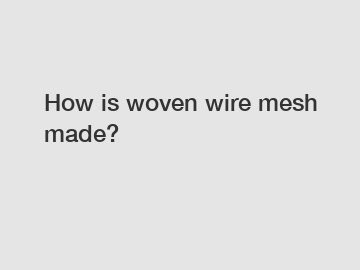How is woven wire mesh made?
Woven wire mesh is a versatile material used in a wide range of industries, including mining, agriculture, and construction. It is essential for filtering, sifting, and protecting various materials. But have you ever wondered how woven wire mesh is made? In this article, we will explore the process of creating this essential material.
**Wire Selection**.
The first step in creating woven wire mesh is selecting the appropriate wire for the application. The wire must meet specific requirements for strength, corrosion resistance, and flexibility. Common materials used for wire mesh include stainless steel, aluminum, and galvanized steel. The wire is typically available in various diameters and strengths, depending on the intended use of the mesh.

**Weaving Process**.
Once the wire has been selected, it is fed into a loom where the weaving process takes place. The loom consists of two sets of wires - the warp wires, which run vertically, and the weft wires, which run horizontally. These wires are interwoven to create the mesh pattern. The weaving process may be done manually or by a machine, depending on the complexity of the design and the volume of mesh needed.
**Mesh Patterns**.
There are several different patterns in which woven wire mesh can be woven, each with its unique characteristics and benefits. Some common patterns include plain weave, twill weave, and Dutch weave. The choice of pattern will depend on factors such as the desired mesh opening size, strength, and stability requirements. Different patterns offer varying levels of airflow, filtration, and support.
**Finishing Touches**.
After the weaving process is complete, the woven wire mesh may undergo additional treatments to improve its performance or appearance. This could include processes such as heat treating, coating, or polishing. These finishing touches can enhance the mesh's resistance to corrosion, abrasion, or harsh environmental conditions. The final product is then inspected for quality before being packaged and shipped to customers.
**Applications**.
Woven wire mesh is used in a wide variety of applications across numerous industries. It is commonly found in security screens, architectural panels, filters, sieves, and fencing. The precise characteristics of woven wire mesh make it suitable for tasks requiring precise filtration, separation, or reinforcement. Its durability, flexibility, and customization options make it a popular choice for manufacturers and builders.
**Conclusion**.
In conclusion, woven wire mesh is a critical material with a wide range of applications. The process of creating woven wire mesh involves selecting the right wire, weaving it into various patterns, and applying finishing touches as needed. The versatility and durability of woven wire mesh make it an essential component in many industries. Whether you need to filter, sift, or protect materials, woven wire mesh offers a reliable solution.
If you are looking for high-quality woven wire mesh for your next project, contact us today. Our team of experts can help you find the perfect mesh solution for your specific needs.
For more Cheap Titanium Wire Mesh Products, Incoloy Woven Mesh, Hastelloy Air-Liquid Filter Chinainformation, please contact us. We will provide professional answers.


